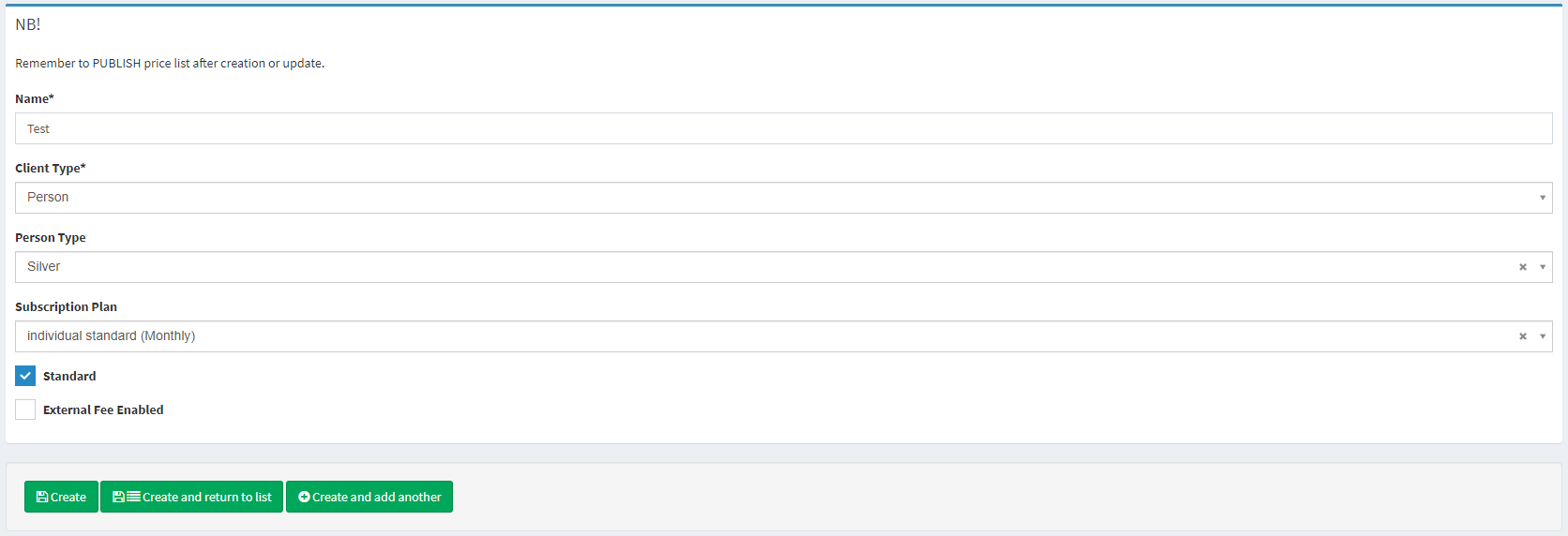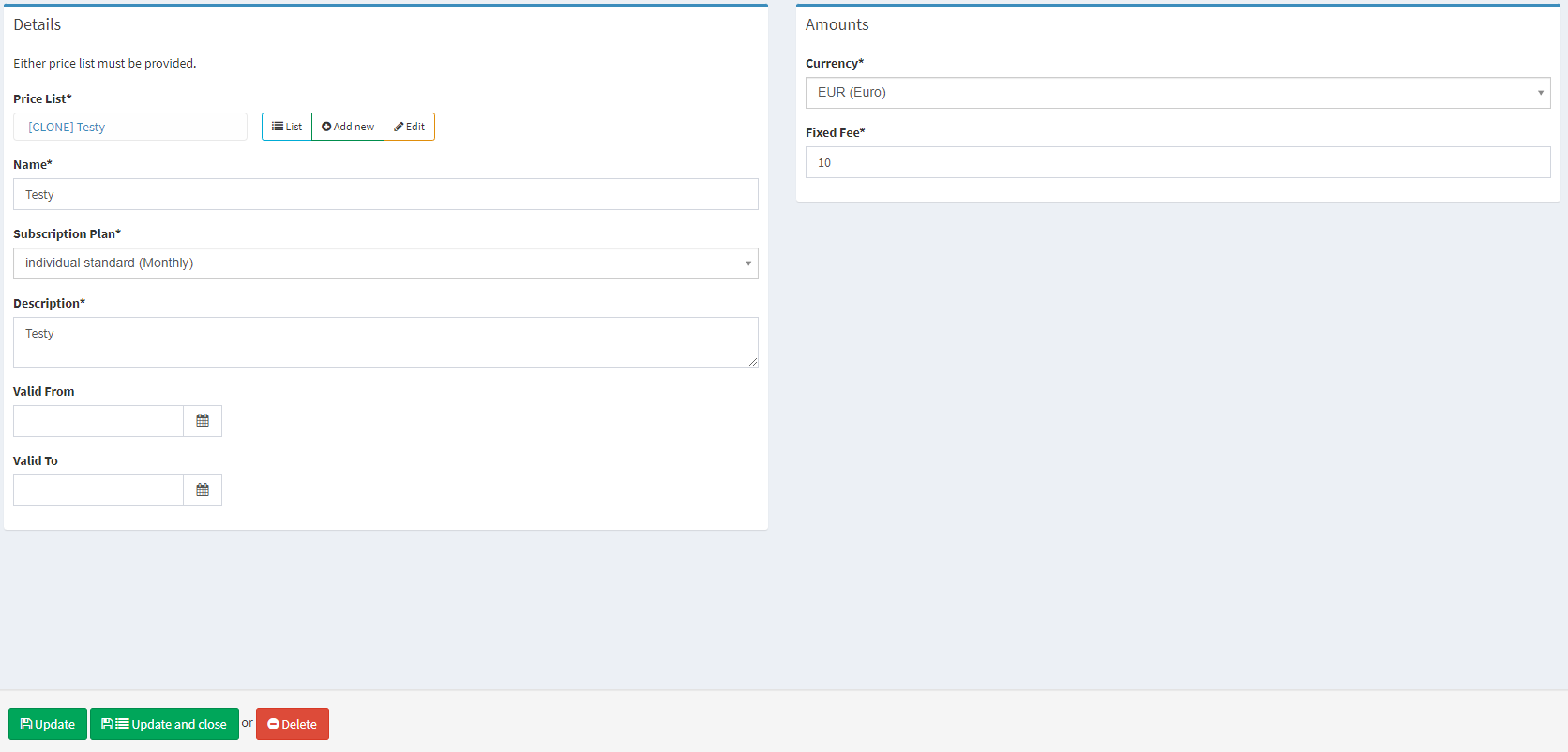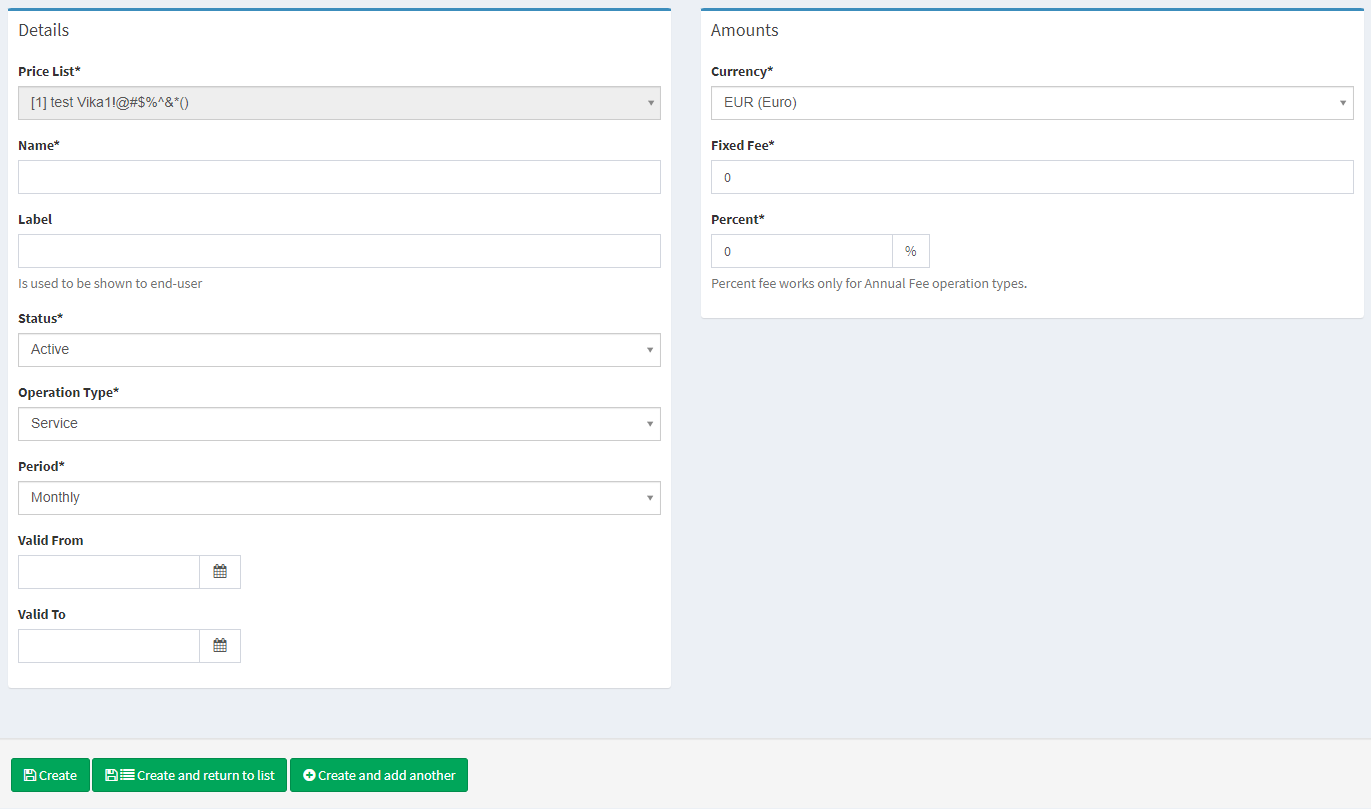Subscriptions
The functionality is to be deprecated in the upcoming releases.
Prerequisites
Make sure that the responsible Administrators are provided with the following actions allowed in the Access roles:
Change Person Subscription Plan Fees
Change Company Subscription Plan Fees
See Access roles (Administration) for configuration details.
How to create a subscription
The subscription creation process consists of the following steps:
Create a set of subscription plans.
Create a price list with fee and reward rules for each subscription plan.
Assign the price lists to each subscription plan created.
To add a new Subscription plan
Navigate to the Dictionary menu item.
The list of active dictionaries will be opened.
Click Add New in the top-right corner of the tab.
Select one of the following Type options:
The Person Subscription Plan dictionary contains the subscription plan labels that will be available as subscription options for persons.
The Company Subscription Plan dictionary contains the subscription plan labels that will be available as subscription options for companies.
Customize the subscription plans as follows (all values are visible to the client via the Web Interface):
Click + to add a new subscription plan label.
Set the Period parameter to define how often the subscription recurring fee should be charged from the client. The following options are available:
Monthly: the subscription fee is to be charged every month.
Yearly: the subscription fee is to be charged annually.
Set the subscription name in the Label field.
Set the Order parameter to define the subscription enumeration if needed.
Use the Markdown syntax to describe the plan in the Description field.
For example:CODEColumn | Column :-- | --: Cell | CellSet one of the labels as Default. The default subscription plan will be active for users with no subscription selected. Thus, older profiles will be automatically assigned to a subscription.
Click Create to save the new Dictionary. The labels will be available in client profiles.
It is possible to set both periods for one subscription—the client will be able to select the preferred option at the moment of upgrade/downgrade. In such a case, create two subscription plans with the identical names and different periods. Two price lists will also be required.

Creating a subscription
How to configure a price list
Once the Dictionary is created, add a new price list for every subscription plan configured previously. The example in the previous image requires three price lists to be created.
To create a Price list
Navigate to the Price lists tab in the Banking sidebar.
The list of price lists will be opened.
Click Add New in the top-right corner to open the price list creation window.
Type in a name for the new price list.
Select a Client type for the Price list: either Person or Company. The price list rules will be applied only to the selected client type.
Select a Subscription plan for the price list to assign it to an exact subscription. The price list will be applied to all clients with the same subscription.
Enable the Standard checkbox for the price list. All price lists created for subscription plans must be of the Standard type.
Click Create to save the price list as a draft.
The new price list will be available in the main list of the Price lists tab.
Configure the necessary fees according to the Price lists page.
The following fees are required for a subscription plan to function:
The Subscription plan fee is a transition fee that is charged to the client at the moment of upgrade/downgrade. The fee is charged according to the price list, which is active for the user before the upgrade/downgrade.
The Recurring fee must be set to define the service fee charged for the subscription. The fee is charged according to the price list, which is active for the user after the upgrade/downgrade.

Creating a price list
If you want to provide different price lists for various client subtypes, make sure each subtype price list is provided with the aforementioned parameters. See Dictionary for details on the subtypes.
How to create a subscription plan fee
The Subscription plan fee tab, available in the top sidebar of a price list, allows you to browse and add a new Subscription plan change rule to the price list.
The functionality is implemented to charge clients when they switch their subscriptions via the Web Interface. The fee is charged according to the price list, which is active for the client before the upgrade/downgrade.
To create a fee for subscription transitioning
Navigate to the Price lists tab in the Banking sidebar.
The list of price lists will be opened.
Select a price list with a Subscription Plan option selected and click Edit.
The price list details window will be opened.
Navigate to Subscription plan fee in the top sidebar.
Click Add New in the top-right corner.
The Price list field value will be automatically filled with the current price list name.
Fill in the Details form. Fields with an asterisk (*) are mandatory.
Set a fee name in the Name field. The name should be identical to the subscription plan name set in the Label field. See Subscriptions for details.
Select a Subscription plan from the drop-down menu to define the target subscription. The transition fee will be charged when upgrading or downgrading to the plan selected.
Add internal details to the Description field.
Set the Valid from and Valid to parameters to define the rule validity period if necessary.
Fill in the Amounts form. Fields with an asterisk (*) are mandatory.
Set the Currency field to define the fee currency. It is recommended to select the default currency allowed by the service provider.
Set the Fixed fee to define the fixed rate. The fixed amount will be charged when upgrading or downgrading from the subscription plan.
Click Create to save the rule parameters. The rule will be added to the price list.
A Subscription plan fee is required for every target subscription plan that is available for upgrade/downgrade. For example, the price list for the Gold (monthly) subscription plan must be provided with transition fees to all other existing plans:
Silver (Monthly) to downgrade.
Silver (Yearly) to downgrade and change the subscription period.
Gold (Yearly) to change the subscription period.
Platinum (Monthly) to upgrade.
Platinum (Yearly) to upgrade and change the subscription period.
Every yearly plan requires a monthly fee of the same level to be configured: Silver (Yearly) cannot be used without Silver (Monthly). Meanwhile, monthly subscriptions may exist without a yearly plan of the same level.

Subscription plan fee
How to create a service fee
The Recurring fees tab, available in the top sidebar of a price list, allows you to configure recurring fees that must be charged from the Client’s Primary account every defined period of time.
Service fee is a maintenance fee defined for a profile and charged for the main banking services.
Additional Account fee is a maintenance fee charged for extra accounts opened by the Client.
Annual Balance fee is a fee that depends on the ending balance held in all accounts opened by the Client. The balance fee can be configured to be daily, monthly, or annually.
Unauthorized Negative Balance fee is a fee charged for overdrawn amounts in accounts. If there is no negative balance during the defined period, the fee is not charged.
Negative Balance is not to be confused with a Credit line. Any unauthorized negative balance appears due to fees charged or POS transactions confirmed later than they should be.
To create a Recurring fee
Navigate to the Price lists tab in the Banking sidebar.
The list of price lists will be opened.
Select a price list for configuration and click Edit.
The price list details window will be opened.
Navigate to Fees in the top sidebar.
Click Add New in the top-right corner.
The Price list field value will be automatically filled with the current price list name. If necessary, change a price list for the rule:
Click List next to the price List field.
Select a price list from the arisen menu.
Fill in the Details form. Fields with an asterisk (*) are mandatory.
Set a name for the new rule.
Optionally, set the Label field to define the name of the fee in Web and Mobile Interfaces.
Set the rule status in the Status field to define whether the fee should be Active or Disabled once it is created. It is possible to change the setting later.
Set the Operation type field to define the transactions covered by the rule. It is possible to select only one transaction type.
Select the time period in the Period drop-down list. The fee will be charged every time period defined in the parameter.
Set the Valid from and Valid to parameters to define the rule validity period.
Fill in the Amounts form. Fields with an asterisk (*) are mandatory.
Set the Currency field to define the fee currency. The parameter is automatically set to the default currency if not specified manually.
Set the Percent parameter if necessary. If set, the annual interest rate on total amounts will be charged every defined period of time. Set to 0, if not required.
Set the Fixed fee to define fixed rates if necessary. If set, the fixed amount will be charged every defined period of time. Set to 0, if not required. The parameters are available for configuration only if a currency is set.
Click Create to save the rule parameters. The rule will be added to the price list.
The Percent parameter can be configured only for Annual Balance and Unauthorized Negative Balance fees.

Creating a recurring fee
How to assign a Price list
Subscription price lists are automatically assigned to subscribed users if the following conditions are met:
Each subscription plan is provided with a price list.
Client profiles are provided with a subscription label. The default subscription is applied to client profiles automatically if no other subscription is set.
The Subscription plan parameter is set for every related price list.
The Subscription plan fee is configured. See Price lists for configuration details.
The Recurring fee is configured to charge service fees according to the Period parameter. See Price lists for configuration details.
There must be no personal price lists configured in client profiles. Personal price lists are of higher priority and cannot be ignored. It is recommended to avoid personal configuration when working with subscriptions.
.png)